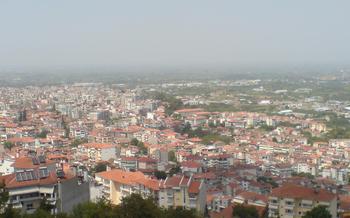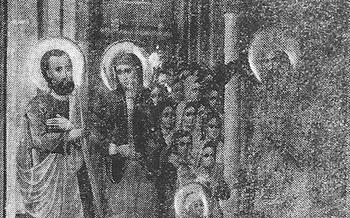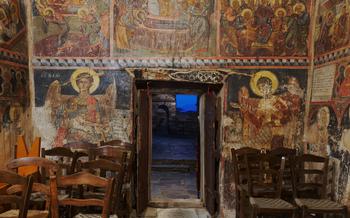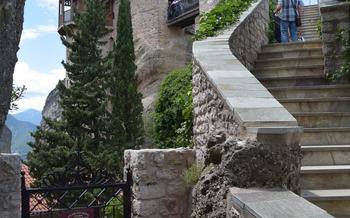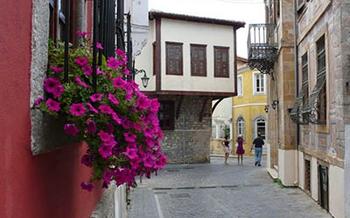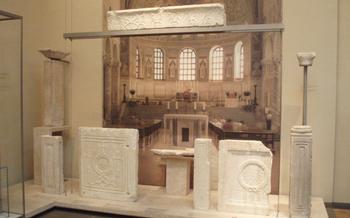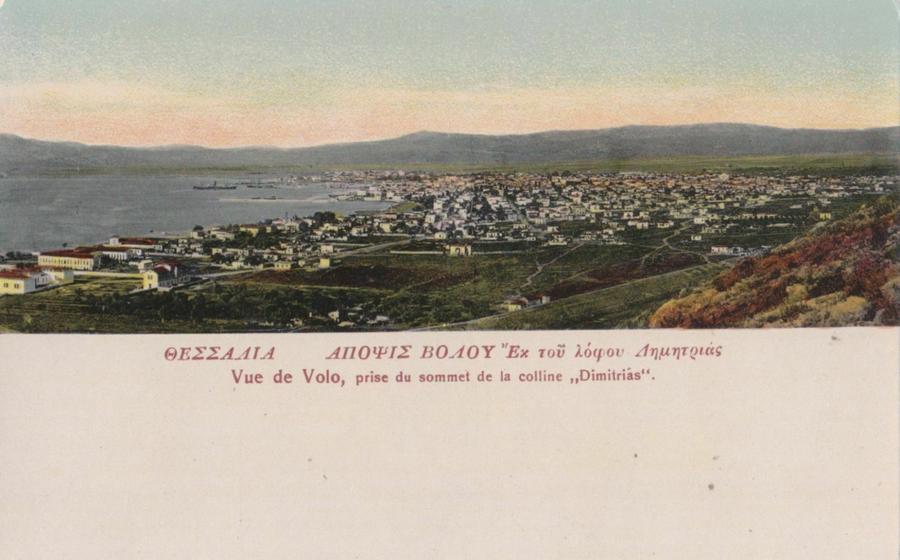
The Church of Saints Constantine and Helena
- The Church of Saints Constantine and Helena: A Historical and Architectural Gem
- Location and Accessibility
- Exploring the Church's Interior
- Marveling at the Exterior Architecture
- Attending Religious Services
- Unveiling the History of the Church
- Discovering the Significance of the Saints
- Participating in Cultural Events
- Finding Souvenirs and Religious Items
- Capturing Memorable Moments
- Combining with Other Attractions
- Finding Accommodation Nearby
- Insider Tip: Hidden Gems
The Church of Saints Constantine and Helena: A Historical and Architectural Gem
In the heart of Volos, nestled amidst charming streets and vibrant markets, stands the awe-inspiring Church of Saints Constantine and Helena, a testament to Greece's rich heritage and architectural splendor. Built in the 19th century, this magnificent edifice is a fusion of Byzantine and Neoclassical architectural elements, creating a harmonious blend of grandeur and elegance. Its towering dome, intricate iconography, and exquisite marble carvings have made it a symbol of religious devotion and cultural pride for the city of Volos.
The church holds a profound religious significance for the Greek Orthodox Christian community, serving as a sacred place of worship and pilgrimage. Dedicated to the revered Saints Constantine and Helena, it attracts numerous pilgrims and visitors who come to seek blessings, pray for miracles, and immerse themselves in the spiritual atmosphere that permeates the church.
Beyond its religious importance, the Church of Saints Constantine and Helena has become an integral part of Volos's cultural landscape. Its unique architectural style and historical significance have made it a popular tourist destination, drawing art enthusiasts, history buffs, and travelers alike. Whether you're a devout believer or simply an admirer of architectural masterpieces, this church is a must-visit destination that promises an unforgettable experience.
Location and Accessibility
The Church of Saints Constantine and Helena is conveniently located in the heart of Volos, making it easily accessible to visitors. The address of the church is 1 Vasileos Georgiou A' Street, and it is situated near the central square of the city. To reach the church, you can either walk from your hotel or take public transportation.
Public transportation options are readily available, with several bus routes stopping nearby. You can catch buses numbered 1, 2, 3, 4, 5, 6, 7, 8, 9, 10, or 11 and get off at the "Church of Saints Constantine and Helena" stop.
Parking is available in the surrounding streets, but it can be limited, especially during peak tourist season. It is recommended to arrive early or consider using public transportation to avoid any parking hassles.
Nearby attractions include the Archaeological Museum of Volos, the Volos City Hall, and the Volos Municipal Theater. You can easily combine a visit to the church with other sightseeing activities in the area.
Exploring the Church's Interior
Inside the Church of Saints Constantine and Helena, visitors are greeted by a breathtaking array of Byzantine mosaics and intricate iconography. The walls and ceilings are adorned with vibrant and well-preserved depictions of biblical scenes, saints, and angels. The mosaics, created by skilled artisans, narrate stories from the Old and New Testaments, offering a visual feast for the eyes.
The iconography within the church is equally impressive. The icons, meticulously painted on wood or canvas, showcase the artistic prowess of Byzantine and post-Byzantine masters. Each icon tells a story, portraying the lives of saints, miracles, and religious events. The intricate details and vibrant colors bring the sacred figures to life, evoking a sense of awe and devotion.
The church's interior also features exquisite marble sculptures and carvings. These works of art, often depicting scenes from the Bible or the lives of the saints, showcase the craftsmanship and artistry of their creators. The marble pulpit, with its intricate carvings and bas-reliefs, is a particularly noteworthy example.
Finally, the altar and sanctuary area of the church exude a sense of sacredness and reverence. The altar, where the Holy Eucharist is celebrated, is adorned with elaborate decorations and precious objects. The sanctuary, with its domed ceiling and ornate iconostasis, provides a focal point for worship and prayer.
Marveling at the Exterior Architecture
The Church of Saints Constantine and Helena captivates visitors with its awe-inspiring exterior architecture. The majestic dome, a symbol of Byzantine grandeur, dominates the skyline and commands attention from afar. Its intricate patterns and gleaming golden cross add an element of opulence to the church's facade.
The bell tower, a testament to the church's historical significance, stands tall and proud beside the dome. Its arched windows and intricate carvings lend a sense of elegance and refinement to the structure. The tower's bells, which chime melodiously throughout the day, add a touch of enchantment to the surroundings.
Ornate facades and arched windows adorn the church's exterior, creating a harmonious blend of architectural styles. Decorative elements and symbols, such as crosses, saints' figures, and biblical scenes, are meticulously carved into the stone, showcasing the artisans' exceptional craftsmanship.
Historical inscriptions and plaques, etched into the walls of the church, provide a glimpse into its rich past. These inscriptions commemorate important events, honor benefactors, and share stories of the church's construction and restoration.
Attending Religious Services
Experience the Local Religious Culture
For a truly immersive experience, consider attending a religious service at the Church of Saints Constantine and Helena. The church holds regular services throughout the week, including daily morning and evening prayers, as well as special services on Sundays and holidays. Visitors are welcome to attend these services and observe the local religious traditions.
Before attending a service, it's important to dress respectfully and follow the local customs. Women should cover their heads with a scarf or shawl, and both men and women should dress modestly. It's also important to be respectful during the service and avoid talking or making noise.
Participating in a religious service at the Church of Saints Constantine and Helena is a unique opportunity to connect with the local community and experience the richness of Greek Orthodox culture. Whether you're a religious person or simply curious about different faiths, attending a service is a meaningful and rewarding experience.
Unveiling the History of the Church
The Church of Saints Constantine and Helena stands as a testament to the rich history of Volos and the Greek Orthodox Church. Its founding and construction date back to the 10th century, during the Byzantine Empire. Over the centuries, the church has undergone several major renovations and restorations, each leaving its mark on the building's architectural style and ornamentation.
In the 16th century, the church was significantly expanded and embellished, reflecting the growing importance of Volos as a religious and commercial center. During this period, the stunning Byzantine mosaics that adorn the interior were created, showcasing intricate iconography and biblical scenes. The marble sculptures and carvings, which depict saints and religious figures, were also added during this time, further enhancing the church's grandeur.
In the 19th century, the church underwent another major renovation, which resulted in the addition of the majestic dome and bell tower. These iconic features, along with the ornate facades and arched windows, give the church its distinctive appearance and make it a prominent landmark in Volos.
Throughout its history, the Church of Saints Constantine and Helena has played a pivotal role in the Greek Orthodox Church. It has served as a center for religious services, community gatherings, and spiritual guidance for the people of Volos. The church has also been a witness to significant historical events and has played a role in shaping the city's cultural identity.
Discovering the Significance of the Saints
The Church of Saints Constantine and Helena draws its name and significance from the esteemed figures of Constantine the Great and his mother, Helena. Constantine, who reigned as Roman Emperor in the 4th century, played a pivotal role in the history of Christianity. He is widely recognized for his Edict of Milan in 313 AD, which granted religious freedom to Christians throughout the empire, effectively ending centuries of persecution. Helena, known for her unwavering devotion, is credited with discovering the True Cross, upon which Jesus Christ was crucified, during her pilgrimage to the Holy Land. Their profound impact on the development of Christianity earned them sainthood and enduring veneration within the Orthodox Church. As patrons of the city of Volos, Saints Constantine and Helena are deeply revered by the local community, who celebrate their feast day with grand festivities and religious processions, further solidifying the church's cultural and spiritual significance.
Participating in Cultural Events
The Church of Saints Constantine and Helena is not just a place of worship; it also serves as a vibrant cultural hub for the local community. Throughout the year, the church hosts a variety of events that celebrate Greek Orthodox traditions and bring people together.
One of the most significant events is the annual feast day of Saints Constantine and Helena, held on May 21st. This joyous occasion features a grand religious procession, where the icons of the saints are carried through the streets of Volos, accompanied by music, dancing, and traditional costumes. The festivities culminate in a lively celebration at the church, with food, music, and dancing.
In addition to religious festivals, the church also hosts cultural events such as concerts, exhibitions, and workshops. These events often showcase the talents of local artists, musicians, and artisans. Visitors can enjoy Byzantine music concerts, admire exhibitions of religious art, or participate in workshops on icon painting, pottery, or traditional dance.
Attending these cultural events is a fantastic way to immerse yourself in the local culture, connect with the community, and gain a deeper appreciation for the rich traditions of the Greek Orthodox Church.
Finding Souvenirs and Religious Items
Finding Souvenirs and Religious Items
The Church of Saints Constantine and Helena offers a unique opportunity to purchase religious souvenirs and items that hold spiritual significance. Inside the church, you may find a small shop or designated area where you can browse a collection of icons, candles, and other religious objects. These items are often handcrafted and blessed, making them meaningful keepsakes for pilgrims and visitors.
In addition to the church shop, you can explore nearby stores and shops that specialize in religious items. Here, you can find a wider variety of icons depicting various saints, crosses, prayer books, and other devotional objects. These stores often carry locally made crafts and handmade souvenirs, which are perfect for those looking for authentic and unique mementos.
When purchasing religious items, it is important to be respectful and mindful of the cultural and spiritual significance they hold. Consider choosing items that are meaningful to you or that represent your personal beliefs and traditions. Books and publications about the history and significance of the church are also available, offering a deeper understanding and appreciation of this sacred place.
Capturing Memorable Moments
When visiting the Church of Saints Constantine and Helena, don't forget to capture the beauty and significance of the moment through photographs. While photography is generally allowed inside the church, it's essential to be respectful of the religious atmosphere and follow any guidelines or restrictions posted.
To capture the best shots, consider the following tips:
-
Composition: Frame your photos to highlight the church's architectural features, such as the dome, bell tower, or intricate facades. Experiment with different angles and perspectives to create dynamic compositions.
-
Lighting: Natural light is often the best for photography, so try to visit the church during the daytime. If you're visiting in the evening, use a tripod or a flash to ensure your photos are well-lit.
-
Posing: If you're taking group photos, pose in front of the church's entrance, under the dome, or next to one of the beautiful mosaics. For individual shots, consider capturing the reflection of the church in the nearby fountain or taking a candid photo while admiring the artwork.
-
Social Media: Share your experiences with the world by posting your photos on social media. Use relevant hashtags and tag the church's official account to connect with other visitors and share your appreciation for this remarkable place of worship.
Combining with Other Attractions
The Church of Saints Constantine and Helena can be seamlessly integrated into a broader exploration of Volos and its surrounding area. The city offers a wealth of historical, cultural, and natural attractions that can be combined to create a customized itinerary.
-
Walking Tours: Embark on a leisurely walking tour that encompasses the church and other notable landmarks, such as the Archaeological Museum of Volos, the Volos Municipal Theater, and the Old Town.
-
Exploring Churches and Monasteries: Discover the rich religious heritage of Volos by visiting other significant churches and monasteries in the region. The Metropolitan Church of Agios Nikolaos, the Monastery of Panagia Gorgoepikoou, and the Monastery of Agios Ioannis Prodromos are among the must-sees.
-
Museums and Galleries: Delve into the history and culture of Volos through its museums and galleries. The Athanasakeion Archaeological Museum, the Volos City Museum, and the Theofilos Museum offer fascinating exhibits on local history, art, and folklore.
Finding Accommodation Nearby
When planning your visit to the Church of Saints Constantine and Helena, finding comfortable and convenient accommodation is essential. Whether you're seeking a luxurious hotel experience, a cozy guesthouse, or a more immersive stay in an apartment or villa, Volos offers a range of options to suit every traveler's needs and budget.
Start your search by exploring hotels and guesthouses in the vicinity of the church. Several establishments are within walking distance, allowing you to easily explore the church and the surrounding area. Look for hotels that offer amenities such as breakfast, parking, and Wi-Fi to enhance your stay.
If you prefer a more independent experience, consider renting an apartment or villa. This option provides flexibility and privacy, allowing you to cook meals, set your own schedule, and immerse yourself in the local lifestyle. Many rental properties in Volos offer stunning views of the city and the surrounding mountains, making them an ideal choice for those seeking a unique and memorable stay.
When selecting accommodation, consider the duration of your visit, your budget, and your personal preferences. If you're traveling during peak season, it's advisable to book your accommodation in advance to secure the best rates and availability.
Here are some tips for choosing the best accommodation near the Church of Saints Constantine and Helena:
-
Location: Prioritize hotels or rentals within walking distance of the church to minimize transportation hassles.
-
Amenities: Consider essential amenities such as breakfast, parking, Wi-Fi, and air conditioning when making your choice.
-
Reviews: Read online reviews and ratings to gauge the experiences of previous guests and make an informed decision.
-
Budget: Set a budget for your accommodation to narrow down your options and find the best value for your money.
-
Booking: Book your accommodation in advance, especially during peak season, to avoid disappointment and secure the best rates.
Insider Tip: Hidden Gems
Beyond the main attractions, Volos hides secret gems waiting to be discovered. Seek out the hidden courtyard behind the church, where ancient ruins blend with modern art installations, creating a unique and serene atmosphere. For a captivating glimpse into the past, explore the underground crypts beneath the church, where centuries-old frescoes and artifacts offer a tangible connection to the church's rich history. Participate in the annual feast of Saints Constantine and Helena, a vibrant celebration that fills the streets with music, dance, and traditional costumes, providing an immersive experience of local culture and religious devotion.
